Boys

Beez Neez now Chy Whella
Big Bear and Pepe Millard
Thu 17 Dec 2009 13:39
|
The Boys are Back in
Town
I waited patiently for twenty eight
weeks and one day to return to Barbuda with the express wish to see the Frigate
Boys doing their stuff. The last time we were here we got to see the mums and
babies - the boys had been in Mexico with their mistresses. As soon as the
anchor was set I was on the phone to Foster, hoping he may say this afternoon
would be the perfect time to go. "Ten in the morning", "are the boys in their
glory?" "The place looks like Christmas trees".
So I had to wait another twenty
hours, Bear somehow knew I wouldn't sleep well. Camera batteries charged, empty
memory cards and bed. Up at silly o'clock, too fidgety for words. Bear had
launched Baby Beez and put the electric motor on so we could hoist her up the
beach. Foster met us on the lagoon side and off we went. Tripod up and ready.
Off we roared on Foster's parogue with the pink interior and his very
quiet 75 hp outboard.
 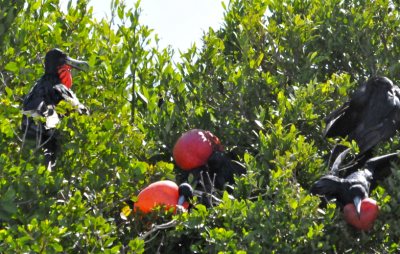 As we approached the sky was full of
these enormous Frigate Birds. Soon enough we saw them
- gulars at the ready - all puffed up
These enormous birds have a wingspan
of eight feet and a body weight of three pounds. They fly at speeds of around
twenty two miles an hour at heights up to two thousand feet. They cannot take
off from the sea or the ground. They have to use their wings to land on a branch
and often look clumsy when others land near them. Frigate birds are relatives of
pelicans, cormorants and boobies. The males are glossy black, females have white
breasts. The immature bird has white heads and necks. The oldest known bird is
thirty four years. They feed on fish from Barbuda's lagoons and interior ponds.
Also flying fish, jelly fish and small turtles taken from the ocean. Adults chase other sea birds to grab
their catch, hence the names, Frigate Bird and Man-o-War
Bird.
  This one had gone so overboard with
his inflation skills he couldn't see anything. This
one was quite heart-shaped and dare I say -
attractive
Males blow up their scarlet throat
sac - gular - to the size of a small balloon, this takes about twenty five
minutes, done to attract the females. When the female approaches the male
trembles his wings showing the under surface, flashing in the sunlight and
making drumming noises and beak clacking. In a colony there are three twig nests
average in an area of nine by twelve feet. There is lots of arguing over landing
rights, perch ownership or who owns each twig. One male and three females
produce two young every two years. One white egg is laid sometime between
mid-September to late March. Incubation is seven weeks, the chick is born naked
but soon acquires white down. The chicks are fed by regurgitation. They fly at
about twenty five weeks after hatching. They are six before they
breed.
 This one was happy
sunning himself. They seemed completely unbothered by
just how close we got to them, so close we could smell the aroma of fish that
they give off
 These liked to be in a tidy row
  Very
exhausting this showing off business
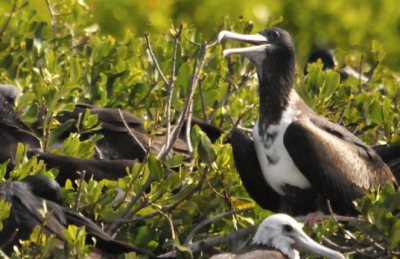  The girls
look on with amusement and some need a look from above
  Can the boys fly
inflated? Course we can
  Can they land
like it? No. They seem to love living in close proximity, returning to
the very bush where they were born
 Lots of preening
to look their best
  We saw a group of Cormorants who had joined the preening group. A few
preferred to live a little less crowded
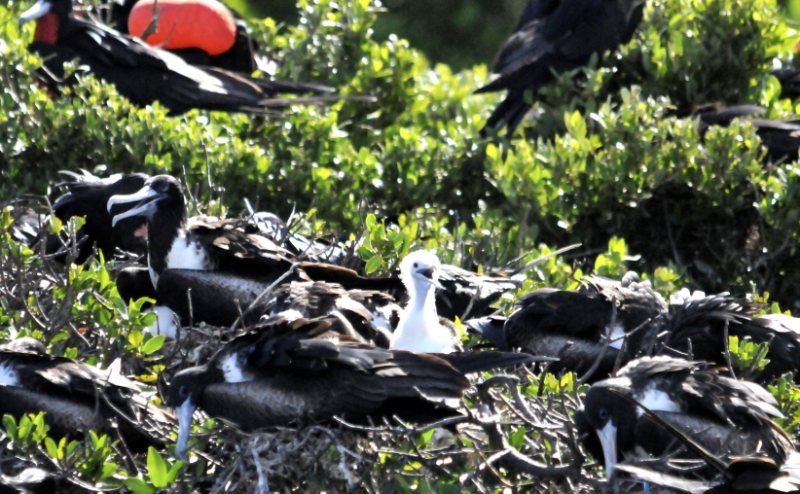 One of the first
of the seasons chicks wanted to know if he would grow up to have one of
those red pouches. No one will know until he is at least a year old. Juveniles
and females have the same colouring.
 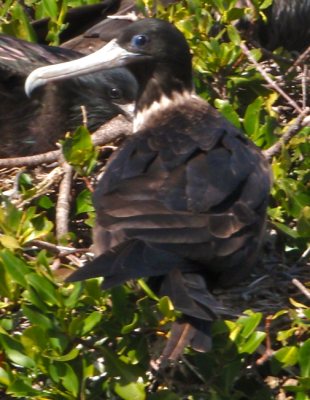 The best looking
male caught the eye of one of the
girls
 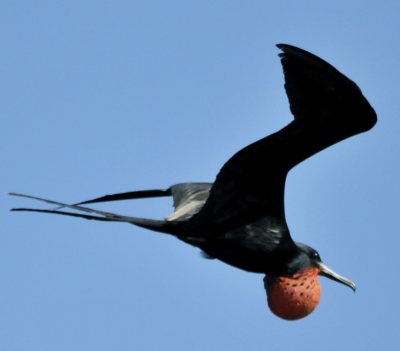 Thank you to Foster and Bear who took me to see a much wished for sight.
The magnificent Frigate Birds
 Simply
stunning
ALL IN ALL WHAT A
WOW
|